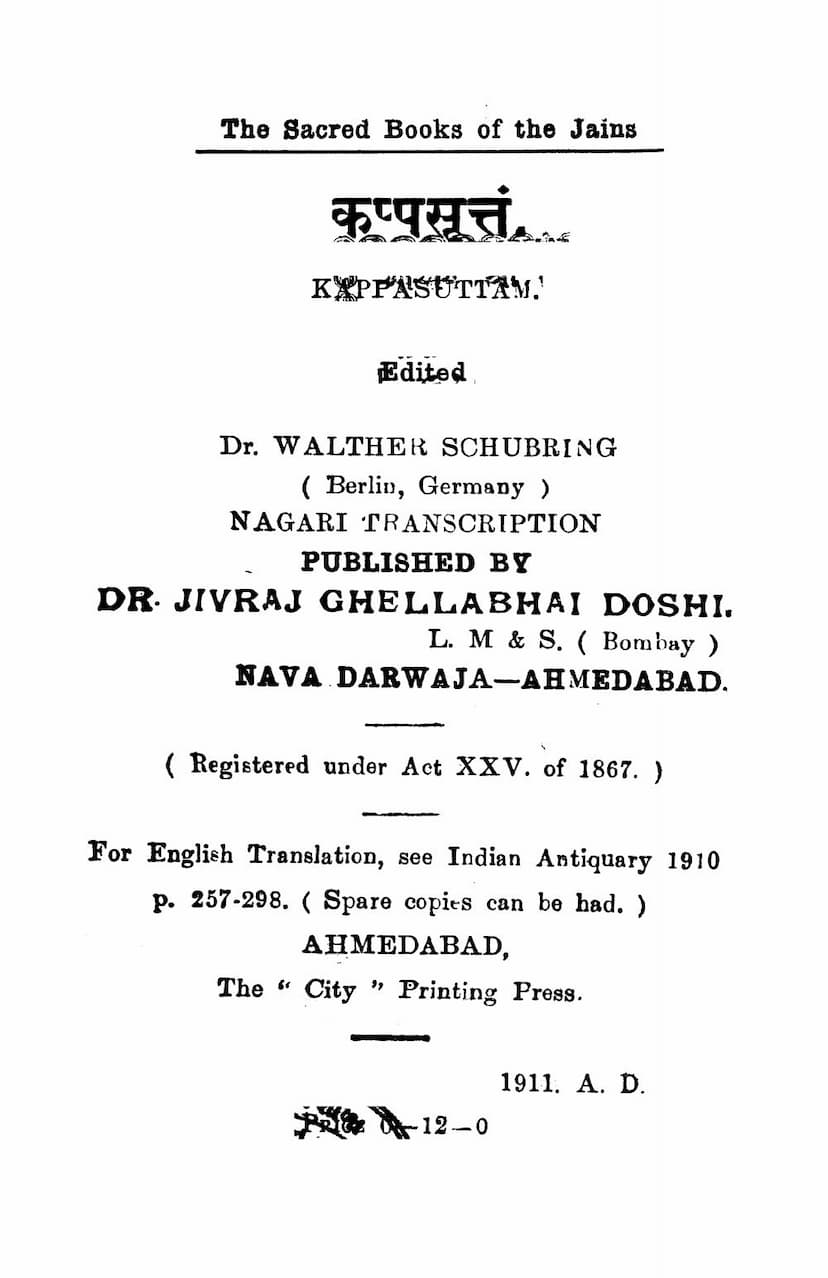Kappasuttam
Added to library: September 2, 2025

Summary
This document is the Kappasuttam (कप्पसुत्तं), a sacred Jain text, edited by Dr. Walther Schubring and published by Dr. Jivraj Ghellabhai Doshi in 1911. The text is presented in Nagari script.
Overview and Purpose:
The Kappasuttam, also known as the Achāranga Sūtra, Chapter 1 (Achāranga Suttam, Adhyayana 1) or simply Achāranga, is one of the fundamental texts of Jainism, specifically belonging to the Āgama literature. Its primary purpose is to lay down the fundamental rules and principles of conduct (āchāra) for Jain ascetics, both monks (Nigranthas) and nuns (Nigranthis). It details what is permissible ("kappai" - कप्पइ) and what is not permissible ("no kappai" - नो कप्पइ) in various situations, covering aspects of their daily life, practices, and interactions with the world.
Content Summary (based on the provided text snippets):
The text is divided into chapters (Adhyāyā or Uddeshas - उद्देसओ) and further into sections or verses (Sūtras - सूत्र). The provided snippets cover the first six chapters, outlining a wide range of regulations:
Key Themes and Regulations:
- Permissible and Impermissible Actions (Kappai and No Kappai): This is the core structure of the text. The sutras repeatedly use these phrases to delineate acceptable behavior for ascetics.
- Housing and Shelter (Uvasaya - उवस्सय): Rules regarding where monks and nuns can reside, including conditions for residing in villages, cities, and protected areas. It specifies permissible times for staying in certain types of dwellings.
- Food and Alms (Bhikshacharyā - भिक्खायरिया): Guidelines on accepting food and alms, including what types of food are permissible, how they should be received, and when. It addresses issues related to the donor, the cleanliness of the food, and the manner of receiving it.
- Clothing and Utensils (Vastra - वत्थ, Patiggaha - पडिग्गह, Kambala - कम्बल, Patipuggala - पडिपुग्गला): Regulations on the type, quantity, and condition of clothing and other essential items that ascetics can possess and use. This includes rules about worn-out clothes, their maintenance, and the use of specific materials.
- Movement and Travel (Charana - चारण): Rules about moving between places, including restrictions on travel during certain times or in certain conditions (e.g., during monsoon season, in specific territories).
- Interaction with the World:
- Lay People (Sāgāria - सागारिय): Guidelines on accepting support from or living with lay followers, including the permissible types of support and the conditions under which it can be accepted.
- Places of Residence and Activity: Restrictions on staying in or engaging in activities within specific locations such as crossroads, markets, or riverbanks.
- Social Interactions: Rules concerning interactions with men and women, including the permissible proximity and manner of interaction.
- Conduct and Practices:
- Speech and Behavior: While not extensively detailed in these snippets, the underlying principle is adherence to righteous conduct.
- Personal Hygiene and Care: Rules related to cleansing, excretion, and other bodily functions.
- Spiritual Practices: Mention of meditation (Dhyāna - झाणं) and contemplation (Kāyotsarga - काउस्सग्गं) and where these can be performed.
- Monastic Hierarchy and Rules: References to superiors like Acharyas (आयरिय), Upadhyayas (उवज्झाय), and Pavartinis (पवत्तिणी), and rules related to seeking their permission or guidance.
- Penances and Expiations (Parihāra - परिहार): The text mentions "Chāumāsika Parihāra" (चाउम्मासियं परिहारट्ठाणं - a penance for a four-month period) as a consequence for violating certain rules.
- Specific Forbidden Actions: The text lists actions like theft, sexual misconduct, lying, and consumption of food after sunset as strictly forbidden.
Editorial Information:
- The edition is based on several manuscripts, including those from the Deccan College Library and Berlin and Vienna libraries.
- The work draws parallels with other Jaina canonical texts like the Kalpa Sūtra and Nīshīth Sūtra.
- An English translation by Miss May S. Burgess of Dr. Schubring's German translation was published in the Indian Antiquary in 1910.
Significance:
The Kappasuttam is a crucial text for understanding the practical aspects of monastic life in Jainism. It provides detailed, often minute, regulations that govern the behavior of ascetics, aiming to ensure their spiritual discipline, non-violence, and detachment from worldly possessions and pleasures. The text reflects a highly organized and disciplined approach to spiritual pursuit within the Jain tradition.